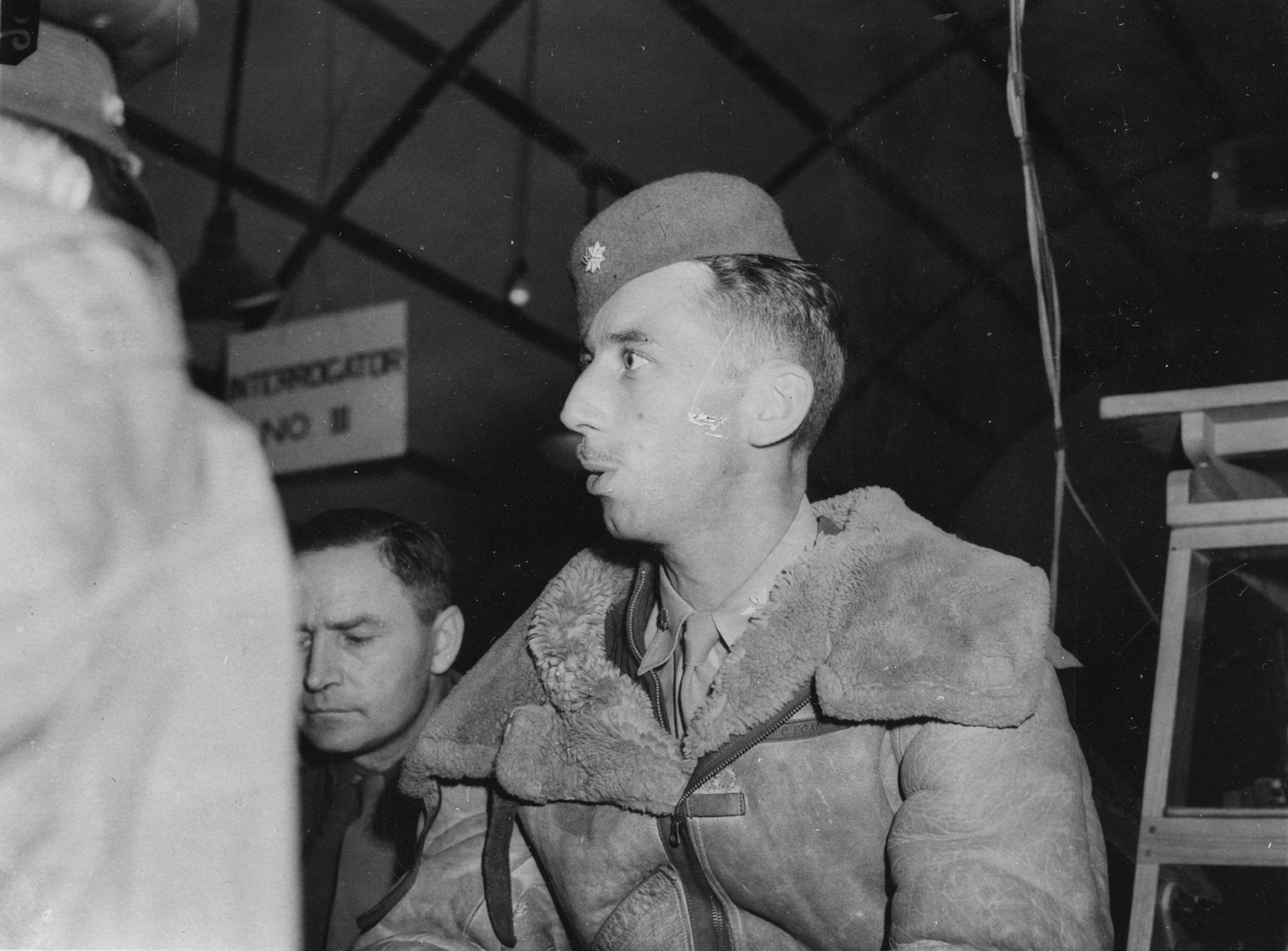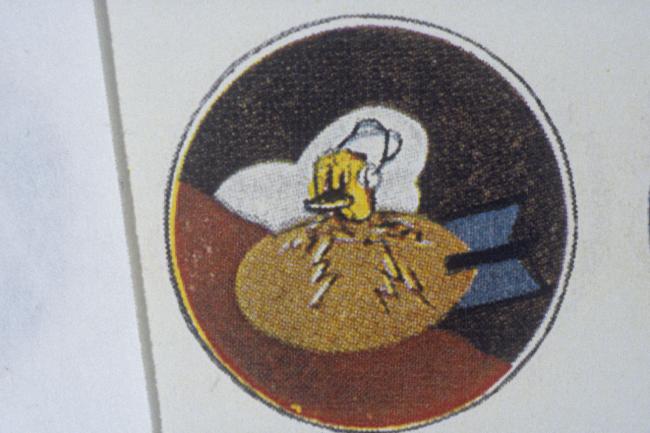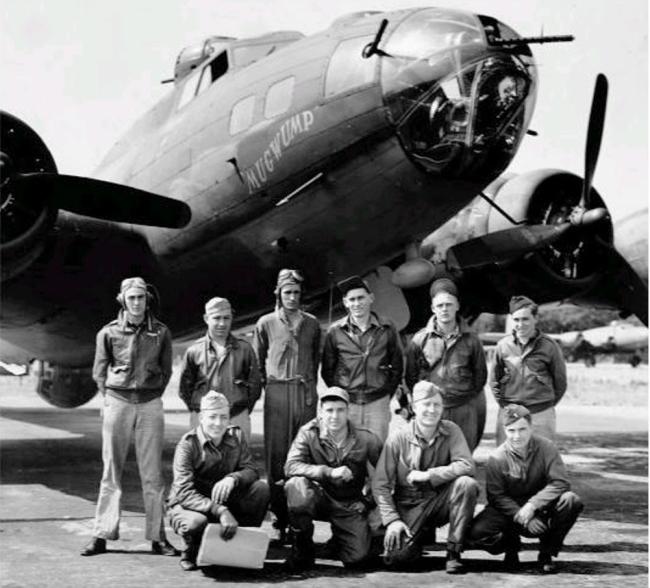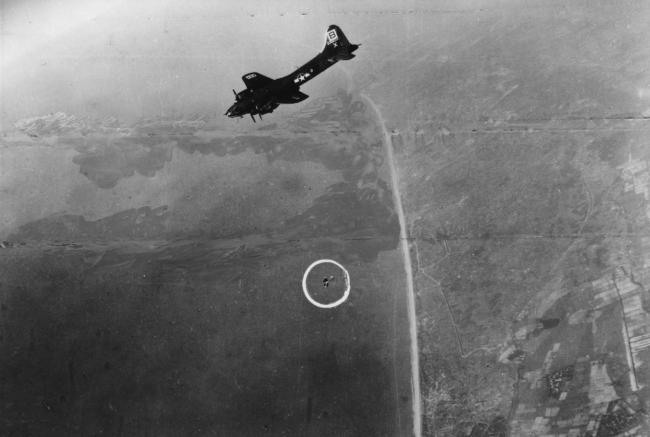John Clarence Egan
Military
IWM, Roger Freeman Collection
Object Number - FRE 4070 - Major John C. Egan, of the 100th Bomb Group, wearing a fez on his return from the Regensburg Shuttle mission. Associated News Story: '"Arabian...
John Clarence “Bucky” Egan was a pilot in the 418th Bomb Squadron, 100th Bomb Group. He was an original member of the 100th, and initially served as its Operations Officer. In June 1943 Egan took over command of the 418th Bomb Squadron, leading his B-17 Flying Forteresses on 12dozen missions, including to Regensburg on 17 August 1943. He was shot down on 10 October 1943 in B-17 Flying Fortress "M'lle Zig Zag" and spent the remainder of the war as a Prisoner of War.
John Egan is portrayed by Callum Turner in Apple TV+'s Masters of the Air (2024).
Biography
John Clarence “Bucky” Egan was considered a role model for the newly arrived air crews joining the 100th Bomb Group at Thorpe Abbotts.
Egan's career began in March 1940 as a Flying Cadet at Randolph Field Texas, where he met his friend Gale Cleven. In April 1942, he was sent to the 29th Bombardment Group as an Instructor, and then in August 1942 was posted to Gowan Army Air Field as Operations Officer for the 100th Bomb Group.
In May 1943 Egan flew with the advance party of the 100th Bomb Group to England, completing two missions with the 305th Bomb Group at Chelveston, before taking over command of the 418th Bomb Squadron at Thorpe Abbotts in June 1943.
Egan, known for wearing a white sheepskin flying jacket, flew on 12 combat missions with the 100th Bomb Group, usually in the co-pilot's seat. As later described by navigator Harry Crosby in his memoir “A Wing and a Prayer” he and Gale Cleven were 'Air Corps raunch, their hats cocked on the back of their heads, ...both wearing white scarves, the souls of romanticism....hated discipline'. In “Splasher Six”, the post-war newsletter of the 100th Bomb Group group, Egan was described as 'a lean dark young man with a wisp of a 27 but looked older. He could turn on the charm and turn it off whenever he liked”. He frequented the local pub in Dickleburgh. Where he sang songs in the bar with the locals. His nickname “Bucky” was acquired when as a cadet he reminded a colleague of someone known as Bucky.
Egan took part in the Regensburg shuttle mission on 17 August 1943. He described the experience later “We were under fighter attack for three and a half hours and saw three Fortresses immediately around us shot down between the German border and the target. No one turned back, although some of us thought we were as good as dead”.
Upon landing in North Africa after the mission, Egan commented, “I never saw such a feeling of fraternity as when we landed. Everyone shook hands and slapped each other on the back, then stamped on the good solid earth”.
On the Munster raid of 10 October 1943 Wgan was Command Pilot - sitting in the right-hand seat - on John Brady's lead crew in “Mlle Zigzag” when they were attacked by over two hundred FW 190's which harried them for 45 minutes. Lt Robert Rosenthal’s “Royal Flush” was the only plane that got back to base.
Two days earlier, Egan's best friend Cleven had gone down on a raid over Bremen and - according to Crosby - Egan had the following day badgered their commanding officer demanding to lead the next mission and avenge his buddy. When Egan eventually arrived at Stalag Luft III, Cleven reportedly greeted him with the words 'What the Hell took you so long?' The two would spend the next eighteen months as prisoners of war.
During the winter months 1944 to 1945 as the Allies were advancing from the west and the Russians closing in from the east. Red Cross parcels were few and far between, the weather was particularly severe and the prisoners saved rations and made preparations for all eventualities. On 17 January 1945 the Germans broadcast news of the Russian advances, and on the evening of 27 January 1945 the order came for the camp to evacuate. An estimated 10,000 men marched out of Sagan in a line fifteen miles long.
The men from Sagan were on the road for five days and nights - Egan recalled one night spent in a “building so infested with bugs that the bunks and straw mattresses were moving by themselves”, before being entrained for Moosburg.
After the end of the Second World War, Egan remained in the US Air Force.. In late1945 he married Josephine Pitz who had been a Women's Air Service Pilot (WASP) assigned to New Castle Air Force Base ferrying B-17s, PT-19s and C-47s. Egan later served in Korea, and following duties in East Asia, attended the National War College in Washington DC.
In July 1958 he was assigned duties in the Policy Division, Directorate of Plans. Egan died in 1961 at the age of 45 of a heart attack and was buried in Arlington National Cemetery with full military honours on 19 April 1961.
Connections
See how this entry relates to other items in the archive by exploring the connections below.
Units served with
![Three airmen of the 100th Bomb Group, Lieutenant Kenneth Menzie, Lieutenant Donald Strout and Lieutenant Norman Scott, plan the route they will take during the next mission in their B-17 Flying Fortress (serial number 42-30380). Image stamped on reverse: 'Reviewed and passed U.S. Army 23 Aug 1943 Press Censor E.T.O. U.S.A.' [stamp]'. Passed for publication 23 August 1943 INTLD 16 General Section Press Censorship Bureau '[stamp], 'Associated Press' [stamp] and '280035.' [Censor no.] Printed caption on reve](https://assets.americanairmuseum.com/s3fs-public/styles/max_650x650/public/freeman/media-378743.jpg?itok=oPPVVi6c)
- Unit Hierarchy: Group
- Air Force: Eighth Air Force
- Type Category: Bombardment

- Unit Hierarchy: Squadron
- Air Force: Eighth Air Force
- Type Category: Bombardment
People
- Military/Civilian/Mascot: Military
- Nationality: American
- Unit: 100th Bomb Group 418th Bomb Squadron
- Service Numbers: 12030515
- Highest Rank: Staff Sergeant
- Role/Job: Top Turret Gunner
- Military/Civilian/Mascot: Military
- Nationality: American
- Unit: 100th Bomb Group 418th Bomb Squadron
- Service Numbers: O-791064
- Highest Rank: Captain
- Role/Job: Pilot

- Military/Civilian/Mascot: Military
- Nationality: American
- Unit: 100th Bomb Group 418th Bomb Squadron
- Service Numbers: 18019531
- Highest Rank: Staff Sergeant
- Role/Job: Waist Gunner

- Military/Civilian/Mascot: Military
- Nationality: American
- Unit: 100th Bomb Group 350th Bomb Squadron
- Service Numbers: O-399782
- Highest Rank: Major
- Role/Job: Pilot
- Military/Civilian/Mascot: Military
- Nationality: American
- Unit: 100th Bomb Group 418th Bomb Squadron
- Service Numbers: 13080480
- Highest Rank: Staff Sergeant
- Role/Job: Ball Turret Gunner
Aircraft

- Aircraft Type: B-17 Flying Fortress
- Nicknames: Just-a-Snappin, Wolff Pack
- Unit: 100th Bomb Group 418th Bomb Squadron

- Aircraft Type: B-17 Flying Fortress
- Nicknames: Mugwump, Rum Boogie II
- Unit: 100th Bomb Group 96th Bomb Group 413th Bomb Squadron 418th Bomb Squadron 803rd Bomb Squadron
- Aircraft Type: B-17 Flying Fortress
- Nicknames: M'lle Zig Zag
- Unit: 100th Bomb Group 418th Bomb Squadron

- Aircraft Type: B-17 Flying Fortress
- Nicknames: Stymie
- Unit: 100th Bomb Group 418th Bomb Squadron

- Aircraft Type: B-17 Flying Fortress
- Nicknames: Just-A-Snappin'
- Unit: 100th Bomb Group 418th Bomb Squadron
Missions

- Date: 10 October 1943

- Date: 4 October 1943
- Date: 2 October 1943

- Date: 27 September 1943
- Date: 9 September 1943
Places

- Site type: Cemetery
- Site type: Prisoner of war camp
- Known as: Dulag Luft Grosstychow Dulag 12

- Site type: Prisoner of war camp
- Known as: Stalag Luft III, Sagan, Germany

- Site type: Airfield
Events
| Event | Location | Date | Description |
|---|---|---|---|
|
Born |
9 September 1915 | ||
|
Other Training |
29 March 1940 - 30 August 1940 | Flying Cadet Randolph Field TX - (with Gale Cleven and Ollen Turner) | |
|
Other Training |
9 September 1940 - 14 November 1940 | Flying Cadet, Kelly Field TX - (with Gale Cleven and Ollen Turner) | |
|
Other Promotion |
15 November 1940 | At Kelly Field, promoted from Flying Cadet to 2nd Lieutenant ACR ( Air Corp Reserve) - (with Egan, Cleven and Ollen Turner) | |
|
Other Promotion |
25 April 1942 | Promoted to 1st Lieutenant, AC (Gale Cleven, John Egan and William Veal) . | |
|
Other Assigned |
25 May 1942 | McDill AAF, 29th Bombardment Group, Lt John Egan, Lt Gale Cleven Lt William Veal, Instructors. | |
|
Other Prisoner of War |
10 October 1943 | Shot down while leading the mission to Munster.Stalag Luft 3 Sagan-Silesia Bavaria (Moved to Nuremberg-Langwasser) 49-11 | |
|
Died |
16 April 1961 | Died from a heart attack. | |
|
Buried |
19 April 1961 | Arlington National Cemetery Sec: 8, Site: 6437-A | |
|
Other Promotion |
Promoted to Captain. | ||
|
Other Assigned |
Gowan Field Army Air Field , Boise Idaho, Operations Officer for 100th Bomb Group (H) | ||
|
Other Assigned |
Walla Walla AAF, WA. | ||
|
Other Assigned |
1942- Wendover AAF | ||
|
Other Promoted |
Promoted to Major. | ||
|
Other Assigned |
Flies with advance party to Podington, England to prepare base for 100th BG. |
Revisions
Added some Punctuation in the "Summary biography" to aid readability.
Updated Born, Died and Buried events per Find-a-grave Memorial ID 49177681.
SOURCE: https://www.findagrave.com/memorial/49177681/john-clarence-egan
Added " / " in the "Role/job" field as a separator to aid readability.
Corrected several typos in the "Summary biography" - "Hundredth. Luftwaffe & Moosburg" were misspelled.
Compiled by Helen Millgate from information in 'Splasher Six' ,100th Bomb Group Foundation at https://www.100thbg.com.
Added a connection to Stalag Luft III per WW2 POW records at the National Archives (NARA).
Added a nickname - see pg. 175 in the book"Flying Fortress" by Edward Jablonski.
Added a connection to the 100th BG - referenced in the book"Flying Fortress" (pg. 173) by Edward Jablonski.
Added a "#" to the A/C serial number in the "Summary biography" to aid clarity & consistency.
Added S/N and POW camp information from WW2 POW records at the National Archives (NARA).
Added a "-" to the A/C serial # in the "Summary biography" for clarity.
Drawn from the records of the National Museum of the Mighty Eighth Air Force, Savannah, Georgia / MACR 1029 / Paul Andrews, Project Bits and Pieces, 8th Air Force Roll of Honor database


![A bomber crew of the 100th Bomb Group plan a route under the engines of their B-17 Flying Fortress. Image stamped on reverse: 'Associated Press.' [stamp], 'Passed for publication 23 Aug 1943.' [stamp] and '280033.' [Censor no.] Printed caption on reverse: 'Men who made shuttle-bombing raid on Regensburg' Associated Press Photo shows: Back Row (left to right) ' T/Sgt Ira Bardman,of Greenlane,Penn; S/Sgt Alfred Clark of Dodge ,Mass;S/Sgt M J Casebolt, of Osborne, Ohio; T/Sgt James W Brady of Long Island N.Y](https://assets.americanairmuseum.com/s3fs-public/styles/max_650x650/public/freeman/media-378754.jpg?itok=psjDM-qy)
